Godtear review
Board games using miniatures for characters and enemies is nothing new. Games Workshop has been doing it for decades, after all, but in recent years it has become more and more prevalent. The rise of 3D printing has allowed smaller companies to get into the space, while relatively large developers like Steamforged Games have been able to climb from strength to strength with titles like Bardsung, and their video game-licensed properties such as Horizon Zero Dawn and Monster Hunter World. Godtear is one of their original IPs, a skirmish game set in a high fantasy world that combines all of their experience into one finely-honed concept.
In the world of Godtear, the actual gods are gone, and the tears shed in their falling have saturated the land with raw power. This has led to the rise of Champions, powerful warriors who lead warbands to lay claim to the Tears and ascend to godhood themselves.
On the surface, Godtear is a simple enough game. Opening up the Eternal Glade starter set (which is the second of two available sets, the first being The Borderlands), I was greeted with a double-sided folded board that offers two different terrains, a few sheets of tokens, a dozen custom Godtear dice, and of course, two sets of impeccably crafted minis.
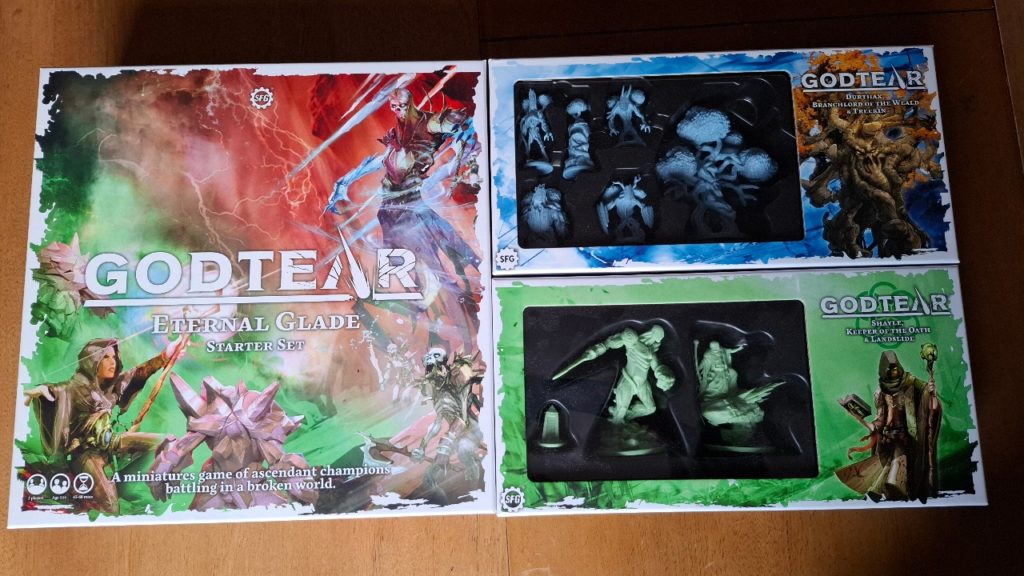
Steamforged Games just don’t disappoint when it comes to their moulds, and Godtear is no exception. In the box we’re given Morrigan, an undead witch with a retinue of skeletons called Coldbloods, and Nia, a druidic summoner who wields nature magic and fights alongside golems hewn from rock. I’ve also been using the Dwarven thain, Rodhri, the druid Shayle, the Ent-like Durthax, and Kailinn the Centaur during my games. Each is incredibly detailed and well-made, and though I haven’t painted mine (yet) I’ve seen how good they look painted up.
Each Champion comes with Followers. Some, like Morrigan and Rodhri have upwards of three, while others like Shayle have one larger Follower. Although there may be multiple miniatures, each Follower behaves as a single unit, even if they’re split around the board. For instance, if you split Rodhri’s four Household Guards into two lots of two, you can only choose one set to cast an action with. We’ll get deeper into it later, but it’s a really interesting system. Champions also come with a Banner model, which is used to claim areas of power and drain the energy from Godtears.
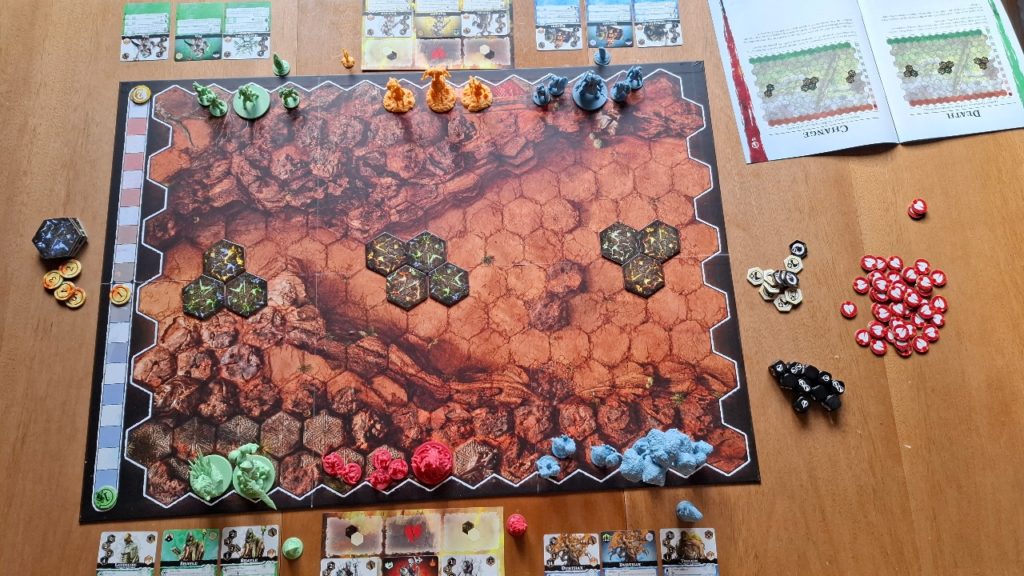
The objective is to finish 5 turns with the most Victory Points, or be the first player to score 10 Victory Points, which ends the game there. Scoring is an intricate little dance in Godtear, too. Each turn you place a turn marker on the scoring ladder, and every time a player scores any amount of points, the token moves that many points (or steps) closer to that player’s side. At the end of the turn, the player whose side it’s in earns the points on the back of the token. Turn tokens are worth different points, too, which allows the tension to ramp up and decrease, as follows:
Turn 1: 1 point
Turn 2: 2 points
Turn 3: 3 points
Turn 4: 2 points
Turn 5: 1 point
The most obvious and universal way to score points is to claim an area of power with your Banner, which gives an instant step on the ladder, while holding a banner until the end of the turn gives a further 4 steps – but there are other ways to score depending on the type of Champion you’re playing, which are explained on the cards that come with them.
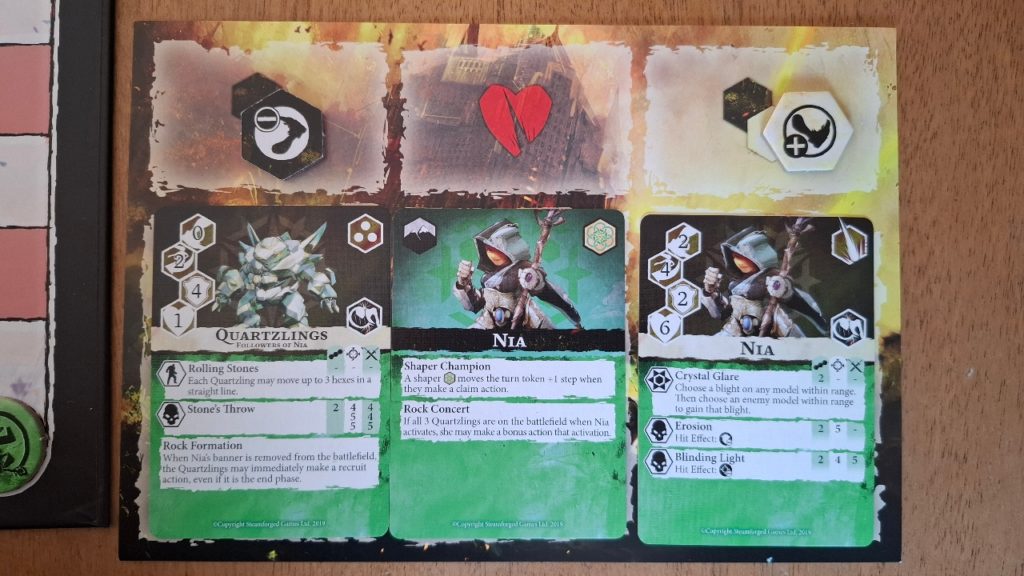
You receive 3 skill cards per warband. The first details all the innate abilities and strengths of the chosen Champion, including their Class. They come in four colours: Red, Green, Blue, and Yellow. Red are Slayers, and gain extra points for knocking out Champions; the green are Shapers, and earn an extra point for placing a Banner; the blue are Guardians, and receive an extra point for placing and holding a Banner until the end of the turn; and the yellow are Maelstroms, who earn more points when they defeat Followers. Each player can take up to three Warbands of any combination of colours, with no limitations on alignment, class, or allegiance.
Although, this is also where Godtear stumbles a little, because each Warband is sold separately and will cost between £18 and £50 generally speaking, and the Starter Sets (priced at around £35 to £40) only come with two each. It gets very expensive very quickly just trying to collect three sets to play against a friend with three, and even more expensive if you want the option of mixing and matching different Champions of your own.
Regardless of your chosen line-up, the game begins with deployment, where you decide who goes first (I like to roll off but it’s not necessary in the rules) and then fully deploy one Warband each into the zone allocated in the chosen scenario. These scenarios are detailed in the Core Book, and determine starting position, placement of points of power, and the conditions of the End Phase of each turn.
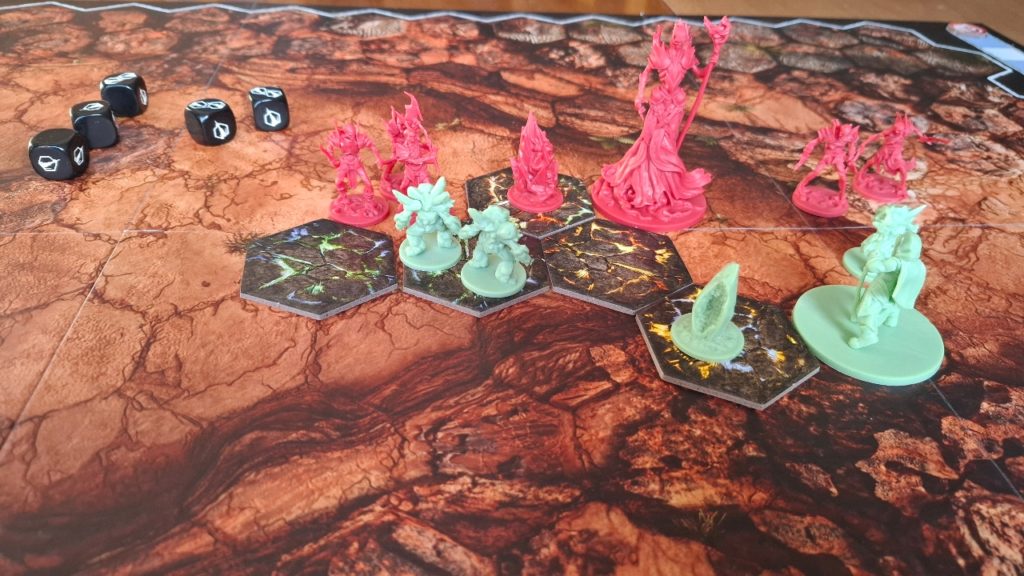
Once deployed you enter the Plot Phase. Both Champions and Followers have a skill card each, with light and dark sides. Light-side skills are used during the Plot Phase. This is where you position your miniatures, cast buffs and other spells, and can plant Banners to syphon Godtears. Generally you won’t cause much damage to each other in this phase but it is possible depending on the Champion. Each card details four primary stats: Movement, Dodge, Defence, and Wounds (HP). You can only move each Follower or Champion as many hexes as indicated by the move stat, but there are many skills you can employ to grant extra movement. Shayle’s large Follower, Landslide, can’t move at all, for example, but can be moved by Shayle using a spell.
Each piece only has two action points per Activation, meaning you can only perform two actions and cannot perform the same action twice, so you can move and attack, or cast a spell, use “Recruit” to return fallen Followers to the board, or gather a defeated Champion and return them to the fray. Once one player has finished their Activations, the other player follows, remembering to place Boon and Blight tokens on the appropriate cards to reflect any buffs or debuffs cast in the Plot Phase. You also turn over the cards to reveal the dark side.
Phase Two is Combat, and here the skills are generally much more offensive and damaging. To cast a skill against an opponent, you must check their Range, Accuracy, and Attack stats. Range is simple to ascertain as it’s given in hexes, but Accuracy and Damage roll directly against the target’s Dodge and Defence stats. So, you select a target and roll a number of dice equal to your Accuracy. The special Godtear dice either have one or two icons, or blank faces. If you roll a number of icons equal to or higher than the target’s dodge, you hit them, and must resolve whatever the Hit Effect of the chosen skill is, usually a debuff. If any dice hit, you then roll dice equal to your Attack stat, and must beat your opponent’s Defence stat. If they have Defence of three, and you roll four hit icons, you deduct the three Defence and score one wound. You can also destroy Banners in this phase, but cannot plant them.
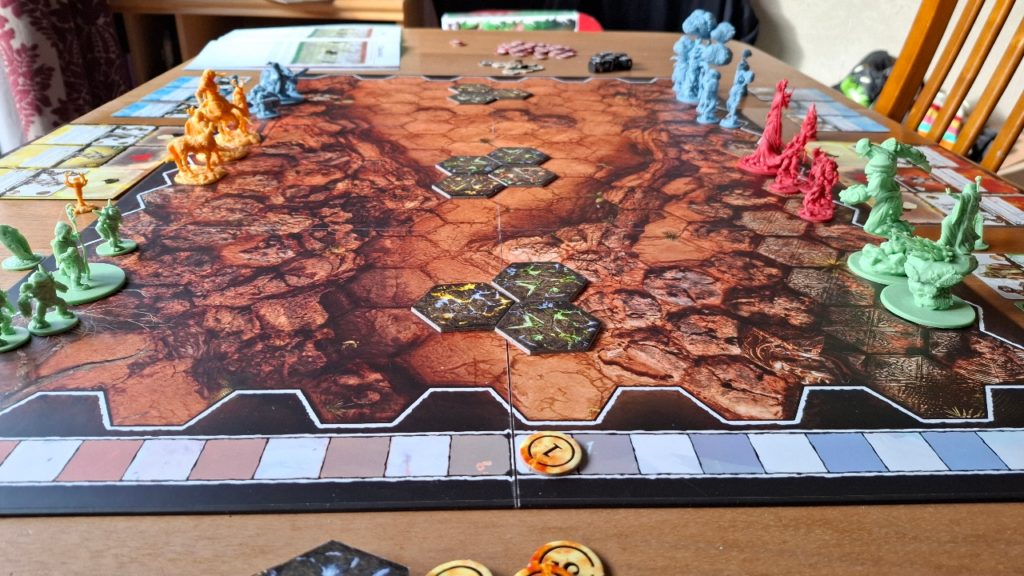
Defeated Followers are returned using the Recruit action, while beaten Champions fall back 2 hexes and must be regrouped using an action in their next Activation. No one dies for good in Godtear, which keeps the action going and points increasing. Where the deeper tactical play comes in is the choosing of your skills and buffs, to increase your stats and weaken an opponent. With only 5 turns, the game can move quickly, but careful thinkers may run games of up to two hours or more. You can always opt to play just one Warband each if you like, to knock out a speedier game.
Godtear is not a lore-heavy game. Not everything needs to be on the scale of Warhammer 40K, but those who really invest in lore will have to dig around a bit to find anything really meaty on Godtear. It’s not essential and there is background stuff to be found on the character cards and packaging – and there’s plenty of stuff online if you look for it, but the game itself doesn’t waste much time with history.
That being said, Godtear is one of the best skirmish games I’ve played in recent months, and takes the tactical thinking of larger games but applies it to an intimate, small form, almost arena-like setting. The basic rules are incredibly simple, which puts the focus on learning how to play each of your Champions, finding synergy in their skills and abilities, and learning how to best weaken and discombobulate your opponent. Its only real downside is how expensive it is, and how much there is to keep track of as you play. The scoring system takes a little getting used to, and you will be referencing your cards an awful lot, but it doesn’t distract from the immersion and fun of playing.




